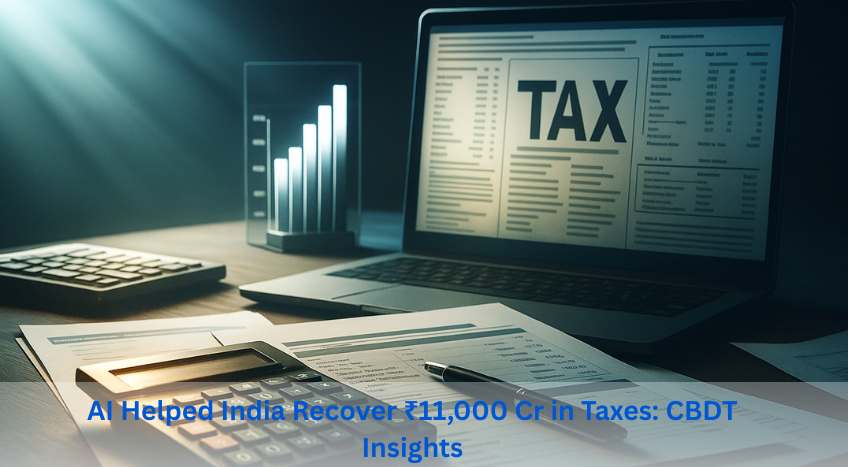
In a bold declaration that marks a turning point in India’s digital governance journey, the Chairman of the Central Board of Direct Taxes (CBDT) recently revealed that Artificial Intelligence (AI) tools have enabled the recovery of over ₹11,000 crore in additional tax revenue in the last four years.
This isn’t just a story about numbers. It’s about how AI is reshaping tax systems, closing loopholes, and helping the government make data-driven, proactive decisions. In a world moving rapidly toward automation and digital intelligence, India’s tax machinery is embracing the future—one algorithm at a time.
🔍 The Role of AI in India’s Tax Intelligence
The integration of AI into India’s tax administration is a significant leap forward in the use of emerging technologies for public governance and financial compliance. With enormous volumes of financial data flowing through various systems, traditional audit methods were no longer sufficient.
That’s where AI-driven systems stepped in.
These tools analyze vast amounts of taxpayer data—from income declarations, GST filings, PAN-linked transactions, to digital payments and financial behaviors—to detect inconsistencies, patterns of evasion, and anomalies that previously went unnoticed.
Key AI Capabilities Used:
Data Mining & Pattern Recognition: AI can uncover patterns in filings that hint at tax evasion.
Predictive Analytics: Systems predict potential defaults and high-risk taxpayers.
Natural Language Processing (NLP): To parse and understand unstructured financial reports.
Automated Red Flag Triggers: Based on mismatches between declarations and spending behavior.
💡 ₹11,000 Crore – A Big Win for AI and Compliance
According to CBDT Chairman Nitin Gupta, AI tools have unearthed fraudulent behavior, non-disclosures, and under-reporting, helping the department bring in over ₹11,000 crore in taxes that would otherwise have slipped through the cracks.
This is not just about recovery. It is a behavioral shift, pushing individuals and businesses to stay compliant because the system is now smart enough to detect irregularities in real-time.
📈 How AI is Redefining the Future of Taxation in India
The CBDT’s move aligns with a broader trend: India’s Digital Transformation in Governance. From faceless assessments to e-verification of documents, and now AI-backed intelligence, India’s tax department is becoming a global example of modern, tech-led regulation.
Here’s what the future looks like:
1. Smarter Compliance Ecosystem
Taxpayers will be auto-alerted to anomalies. Filings will be cross-verified using AI in real-time, reducing delays, errors, and fraud.
2. Less Human Intervention
AI removes subjectivity. With faceless assessments and AI-assisted scrutiny, the system becomes more transparent and consistent.
3. Targeted Enforcement
Instead of random audits, AI helps the government pinpoint potential defaulters, saving resources and time.
4. Increased Voluntary Compliance
As the system gets smarter, taxpayers are more likely to stay honest, knowing their data is continuously monitored.
🛡️ The Flip Side: Privacy, Ethics & AI Governance
While AI brings unprecedented efficiency, it also raises questions about data privacy, algorithmic bias, and transparency. The government needs to ensure that:
AI audits are explainable and fair.
Data usage complies with India’s data protection laws.
Citizens are protected from false positives.
This creates a need for AI Governance frameworks, something the Indian government is already exploring under the Digital India program.
💬 What It Means for Businesses & Professionals
For businesses, particularly MSMEs and large enterprises, this shift means it’s time to adopt technology-backed compliance tools. Manual entries, outdated accounting, or ignoring audit trails can now have real consequences.
Here’s how professionals can prepare:
Embrace digital bookkeeping and e-invoicing.
Use AI-based financial management tools for better accuracy.
Stay updated with tax regulations and AI developments.
🤖 AI and Tax Tech – The Future is Here
The use of AI by the Income Tax Department is just the beginning. The same principles can be applied across customs, indirect tax (GST), and even state-level financial monitoring. Over time, AI-powered tools will drive a smart tax ecosystem, ensuring better resource allocation, public trust, and higher tax morale.
🔚 Conclusion
The ₹11,000 crore milestone is a testament to how data and AI can solve complex governance problems. It’s not just about catching defaulters—it’s about making the system smarter, faster, and fairer for everyone.
At Aixcircle, we believe this transformation offers a clear message: AI isn’t the future—it’s the present. Whether you’re a taxpayer, an enterprise, or a policymaker, adapting to this AI-driven ecosystem is no longer optional—it’s essential.

